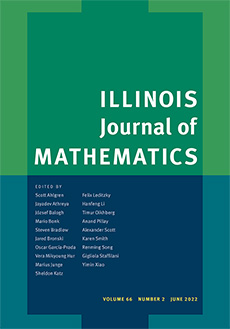Abstract
We show that a certain model for the spread of an infection has a phase transition in the recuperation rate. The model is as follows: There are particles or individuals of type $A$ and type $B$, interpreted as healthy and infected, respectively. All particles perform independent, continuous time, simple random walks on $\mathbb{Z}^d$ with the same jump rate $D$. The only interaction between the particles is that at the moment when a $B$-particle jumps to a site which contains an $A$-particle, or vice versa, the $A$-particle turns into a $B$-particle. All $B$-particles recuperate (that is, turn back into $A$-particles) independently of each other at a rate $\la$. We assume that we start the system with $N_A(x,0-)$ $A$-particles at $x$, and that the $N_A(x,0-), \, x \in \mathbb{Z}^d$, are i.i.d., mean $\mu_A$ Poisson random variables. In addition we start with one additional $B$-particle at the origin. We show that there is a critical recuperation rate $\la_c > 0$ such that the $B$-particles survive (globally) with positive probability if $\la < \la_c$ and die out with probability 1 if $\la > \la_c$.
Citation
Harry Kesten. Vladas Sidoravicius. "A phase transition in a model for the spread of an infection." Illinois J. Math. 50 (1-4) 547 - 634, 2006. https://doi.org/10.1215/ijm/1258059486
Information





